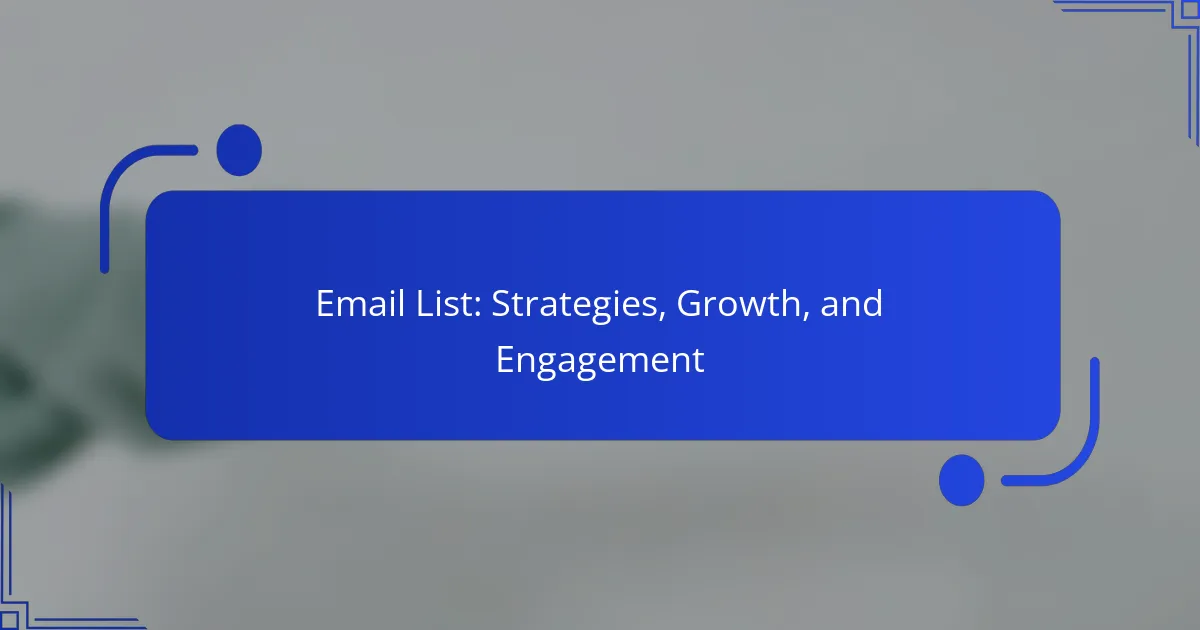Building and maintaining a robust email list is essential for effective communication and marketing. By employing targeted strategies to attract and engage subscribers, you can significantly improve your email list’s growth and interaction rates. Utilizing the right tools can further streamline your efforts, allowing for better organization and performance analysis.
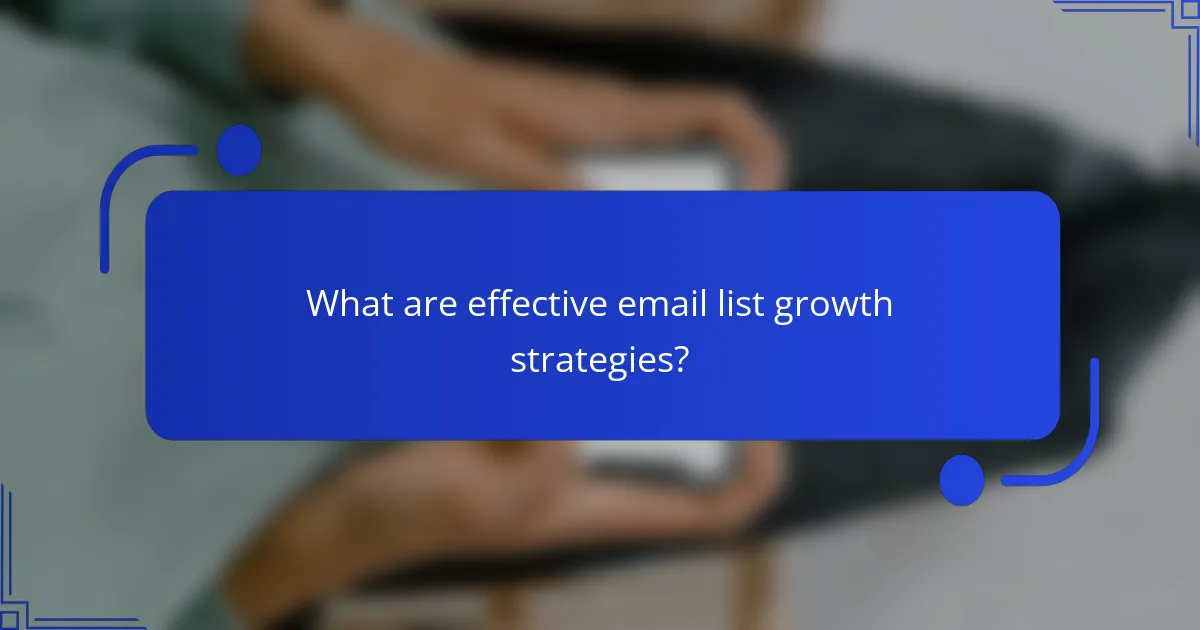
What are effective email list growth strategies?
Effective email list growth strategies focus on attracting and retaining subscribers through valuable content and incentives. Implementing various tactics can significantly enhance your email list size and engagement rates.
Content upgrades
Content upgrades are targeted offers that complement existing content, encouraging visitors to subscribe for additional resources. For example, if you have a blog post about digital marketing, you might offer a downloadable checklist or eBook related to that topic in exchange for an email address.
To maximize effectiveness, ensure that the upgrade is relevant and provides real value. Use clear calls to action and position the upgrade prominently on your website or blog.
Lead magnets
Lead magnets are incentives designed to attract potential subscribers by offering something of value, such as free trials, discounts, or exclusive content. Common lead magnets include eBooks, whitepapers, and templates that address specific pain points of your target audience.
When creating a lead magnet, focus on quality and relevance to your audience’s interests. Make sure the offer is compelling enough to encourage sign-ups, and promote it through various channels to maximize reach.
Social media promotions
Social media promotions can effectively drive traffic to your email sign-up forms. By sharing engaging posts, stories, or ads that highlight the benefits of subscribing, you can attract new subscribers from your social media audience.
Consider using targeted ads on platforms like Facebook or Instagram to reach specific demographics. Regularly engage with your audience and provide clear links to your sign-up forms to facilitate easy subscription.
Referral programs
Referral programs incentivize existing subscribers to refer new subscribers, creating a network effect. You can offer rewards, such as discounts or exclusive content, to both the referrer and the new subscriber, making it a win-win situation.
To implement a successful referral program, clearly communicate the benefits and make the referral process simple. Track referrals effectively to ensure that rewards are distributed promptly.
Webinars and events
Hosting webinars and events can be a powerful way to grow your email list. By providing valuable insights or training sessions, you can attract attendees who are interested in your expertise and willing to share their email addresses for future communications.
Promote your webinars through multiple channels, and ensure that registration requires an email address. Follow up with participants afterward to nurture relationships and encourage further engagement.
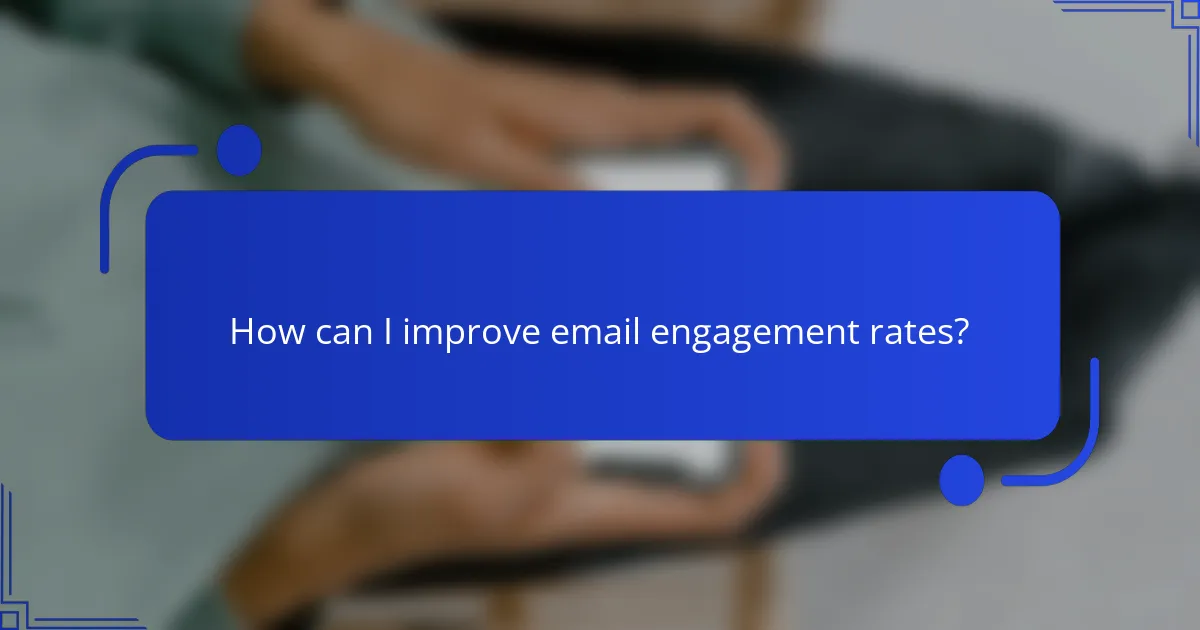
How can I improve email engagement rates?
Improving email engagement rates involves enhancing how recipients interact with your emails. Key strategies include personalizing content, segmenting your audience, testing subject lines, and optimizing send times.
Personalization techniques
Personalization techniques significantly boost engagement by tailoring content to individual preferences. Use the recipient’s name in the subject line and body, and recommend products based on past purchases or browsing behavior.
Consider dynamic content that changes based on user data, such as location or demographics. For example, a clothing retailer might show different seasonal collections based on the recipient’s region.
Segmentation strategies
Segmentation strategies involve dividing your email list into smaller groups based on shared characteristics. This allows you to send more relevant content, which can lead to higher open and click-through rates.
Common segmentation criteria include demographics, purchase history, and engagement levels. For instance, you might create segments for new subscribers, frequent buyers, and inactive users, tailoring messages accordingly.
A/B testing subject lines
A/B testing subject lines helps determine which phrases resonate best with your audience. By sending two variations of a subject line to a small sample of your list, you can analyze which one achieves a higher open rate.
Focus on elements such as length, tone, and urgency. For example, a subject line like “Last Chance for 20% Off!” may perform better than “Discount Offer Inside” due to its sense of urgency.
Optimizing send times
Optimizing send times can significantly impact engagement rates. Analyze your audience’s behavior to determine when they are most likely to open emails, typically during weekdays in the late morning or early afternoon.
Consider using tools that allow you to test different send times and track performance. You might find that sending emails on Tuesdays and Thursdays yields better results than Mondays or Fridays.
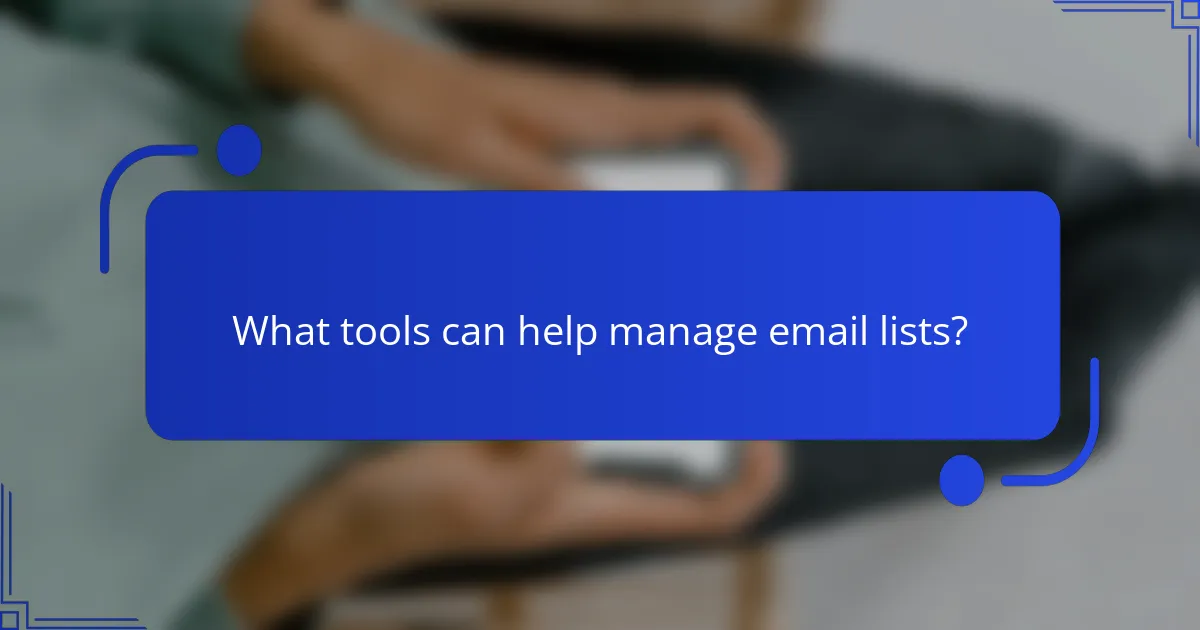
What tools can help manage email lists?
Several tools can effectively manage email lists, helping you organize contacts, automate campaigns, and analyze performance. Popular options include Mailchimp, Constant Contact, ActiveCampaign, and ConvertKit, each offering unique features tailored to different needs.
Mailchimp
Mailchimp is a widely used email marketing platform known for its user-friendly interface and robust features. It offers tools for list segmentation, automation, and analytics, making it suitable for both beginners and experienced marketers.
With pricing tiers ranging from free for basic features to paid plans for advanced functionalities, Mailchimp allows you to scale your email marketing efforts. Consider using its A/B testing feature to optimize your campaigns effectively.
Constant Contact
Constant Contact is designed for small businesses and nonprofits, providing an intuitive platform for managing email lists and campaigns. It includes features like customizable templates, list segmentation, and social media integration.
Pricing starts at a moderate monthly fee, which varies based on the number of contacts. Its event marketing tools are particularly beneficial for organizations looking to promote events or fundraisers.
ActiveCampaign
ActiveCampaign combines email marketing with customer relationship management (CRM) capabilities, making it ideal for businesses focused on automation and personalized communication. It offers advanced segmentation and automation workflows to enhance engagement.
Pricing is tiered based on features and contact count, with options for small to large businesses. Take advantage of its predictive sending feature to improve open rates by sending emails at optimal times for your audience.
ConvertKit
ConvertKit is tailored for creators, bloggers, and online entrepreneurs, focusing on simplicity and ease of use. It allows users to create landing pages and manage email lists effectively, with a strong emphasis on automation.
ConvertKit offers a free plan for up to a limited number of subscribers, with paid plans that provide additional features. Utilize its tagging system to categorize subscribers based on their interests and behaviors for more targeted campaigns.

What are the best practices for email list maintenance?
Effective email list maintenance involves regularly updating and optimizing your subscriber list to enhance engagement and deliverability. Key practices include cleaning the list, monitoring engagement metrics, and implementing double opt-in processes.
Regularly cleaning the list
Regularly cleaning your email list is essential for maintaining high deliverability rates and engagement levels. This process involves removing inactive subscribers, correcting invalid email addresses, and eliminating duplicates. Aim to clean your list every few months to ensure it remains relevant and effective.
To clean your list, consider using automated tools that can identify and remove inactive users based on specific criteria, such as no opens or clicks in the last six months. This helps maintain a healthy sender reputation and improves overall campaign performance.
Monitoring engagement metrics
Monitoring engagement metrics is crucial for understanding how your audience interacts with your emails. Key metrics include open rates, click-through rates, and unsubscribe rates. Regularly analyzing these metrics allows you to identify trends and make informed decisions about your email content and strategy.
Set benchmarks for your metrics based on industry standards, which can vary but typically range from 15-25% for open rates and 2-5% for click-through rates. Adjust your email strategies based on these insights to enhance engagement and retain subscribers.
Implementing double opt-in
Implementing a double opt-in process ensures that subscribers confirm their interest in receiving emails from you. This practice not only helps to build a more engaged list but also reduces the chances of spam complaints. When a user signs up, they receive a confirmation email that they must respond to before being added to your list.
This method can lead to higher quality leads, as it filters out those who may not be genuinely interested. While it may slightly reduce initial sign-up rates, the quality of your subscriber base will improve, resulting in better engagement and lower unsubscribe rates in the long run.
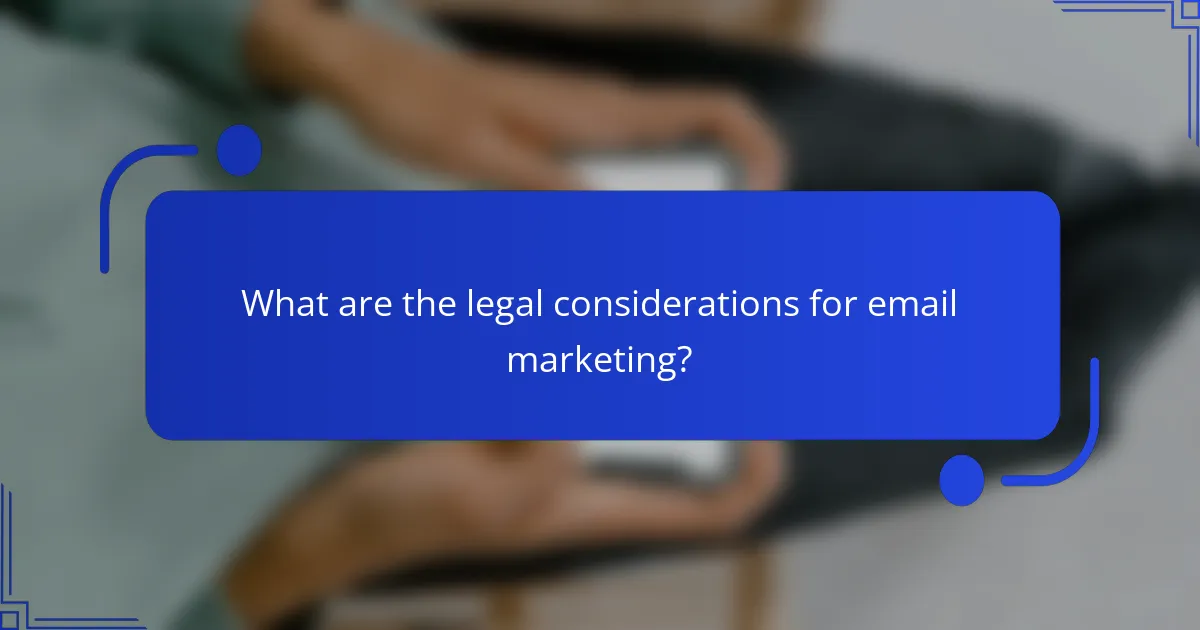
What are the legal considerations for email marketing?
Email marketing involves various legal considerations that marketers must adhere to in order to avoid penalties and ensure compliance. Key regulations such as GDPR and the CAN-SPAM Act govern how businesses can collect, store, and use email addresses for marketing purposes.
GDPR compliance
The General Data Protection Regulation (GDPR) applies to businesses operating within the European Union or targeting EU residents. It mandates that businesses obtain explicit consent from individuals before sending marketing emails, ensuring that recipients are fully informed about how their data will be used.
To comply with GDPR, companies should implement clear opt-in mechanisms, provide easy access to privacy policies, and allow users to withdraw consent at any time. Failure to comply can result in hefty fines, often reaching up to 4% of annual global turnover.
CAN-SPAM Act regulations
The CAN-SPAM Act governs email marketing in the United States, requiring businesses to follow specific rules when sending commercial emails. Key requirements include providing a clear opt-out option, including the sender’s physical address, and ensuring that the subject line accurately reflects the content of the email.
Marketers should regularly monitor their email lists to remove unsubscribed users promptly. Violations of the CAN-SPAM Act can lead to fines of up to $43,000 per email, making compliance essential for any email marketing strategy.
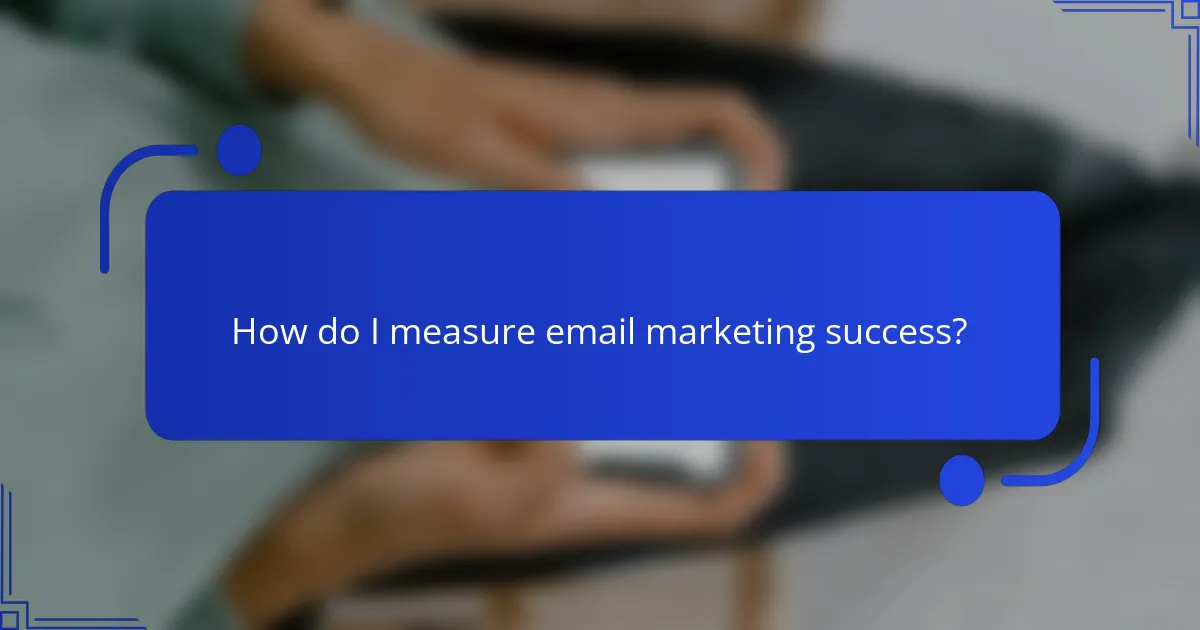
How do I measure email marketing success?
Measuring email marketing success involves tracking key performance indicators (KPIs) that reflect the effectiveness of your campaigns. Common metrics include open rates, click-through rates, conversion rates, and unsubscribe rates, which provide insights into engagement and overall performance.
Key Performance Indicators (KPIs)
Key performance indicators (KPIs) are essential for evaluating the success of your email marketing efforts. The most critical KPIs include:
- Open Rate: Indicates the percentage of recipients who opened your email.
- Click-Through Rate (CTR): Measures the percentage of recipients who clicked on links within your email.
- Conversion Rate: Reflects the percentage of recipients who completed a desired action, such as making a purchase.
- Unsubscribe Rate: Shows the percentage of recipients who opted out of your email list.
These metrics help you identify strengths and weaknesses in your campaigns, allowing for data-driven adjustments.
Tools for Measurement
Utilizing the right tools can streamline the process of measuring email marketing success. Popular email marketing platforms like Mailchimp, Constant Contact, and HubSpot provide built-in analytics to track KPIs effectively.
These tools often offer dashboards that display real-time data, making it easier to analyze trends over time. Look for features that allow A/B testing to compare different email strategies and optimize performance.
Interpreting Results
Interpreting results from your email campaigns requires understanding the context behind the numbers. For instance, a high open rate but low click-through rate may indicate that your subject lines are effective, but the content is not engaging enough.
Consider industry benchmarks when evaluating your metrics. For example, average open rates typically range from 15% to 25%, while click-through rates can vary from 2% to 5%. Use these benchmarks to set realistic goals and identify areas for improvement.
Continuous Improvement
To ensure ongoing success in email marketing, adopt a mindset of continuous improvement. Regularly review your KPIs and adjust your strategies based on what the data reveals. Experiment with different subject lines, content formats, and sending times to see what resonates best with your audience.
Additionally, consider segmenting your email list to tailor messages to specific groups, which can enhance engagement and conversion rates. Remember that email marketing is an evolving field, so staying updated on best practices and trends is crucial for sustained success.
